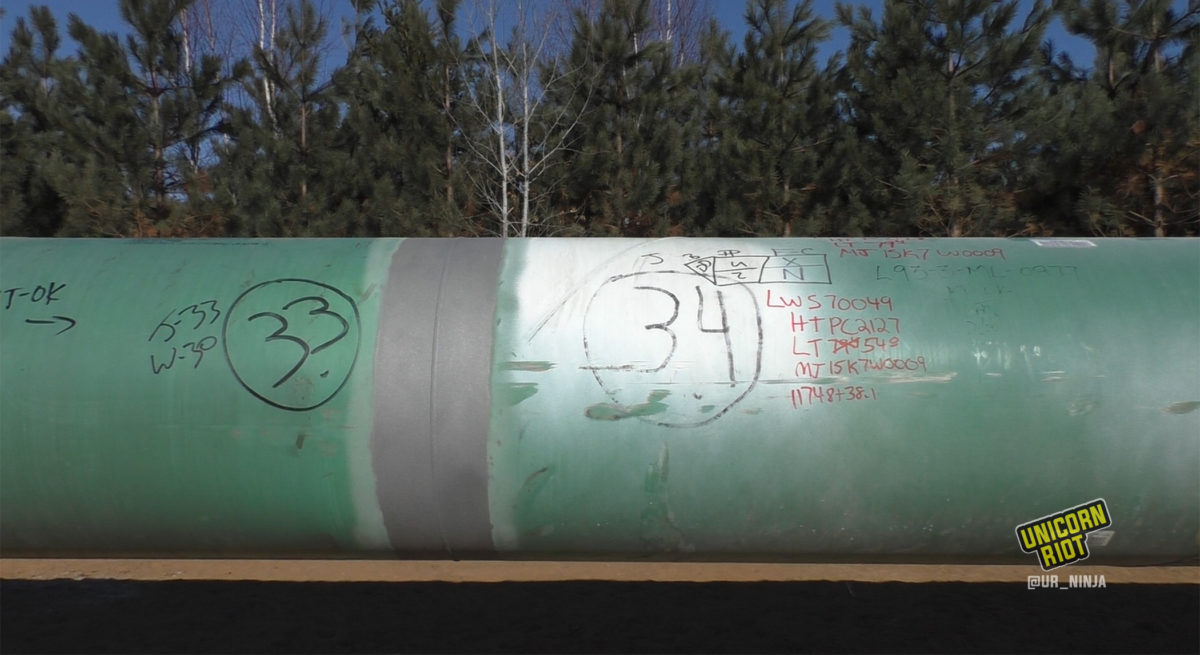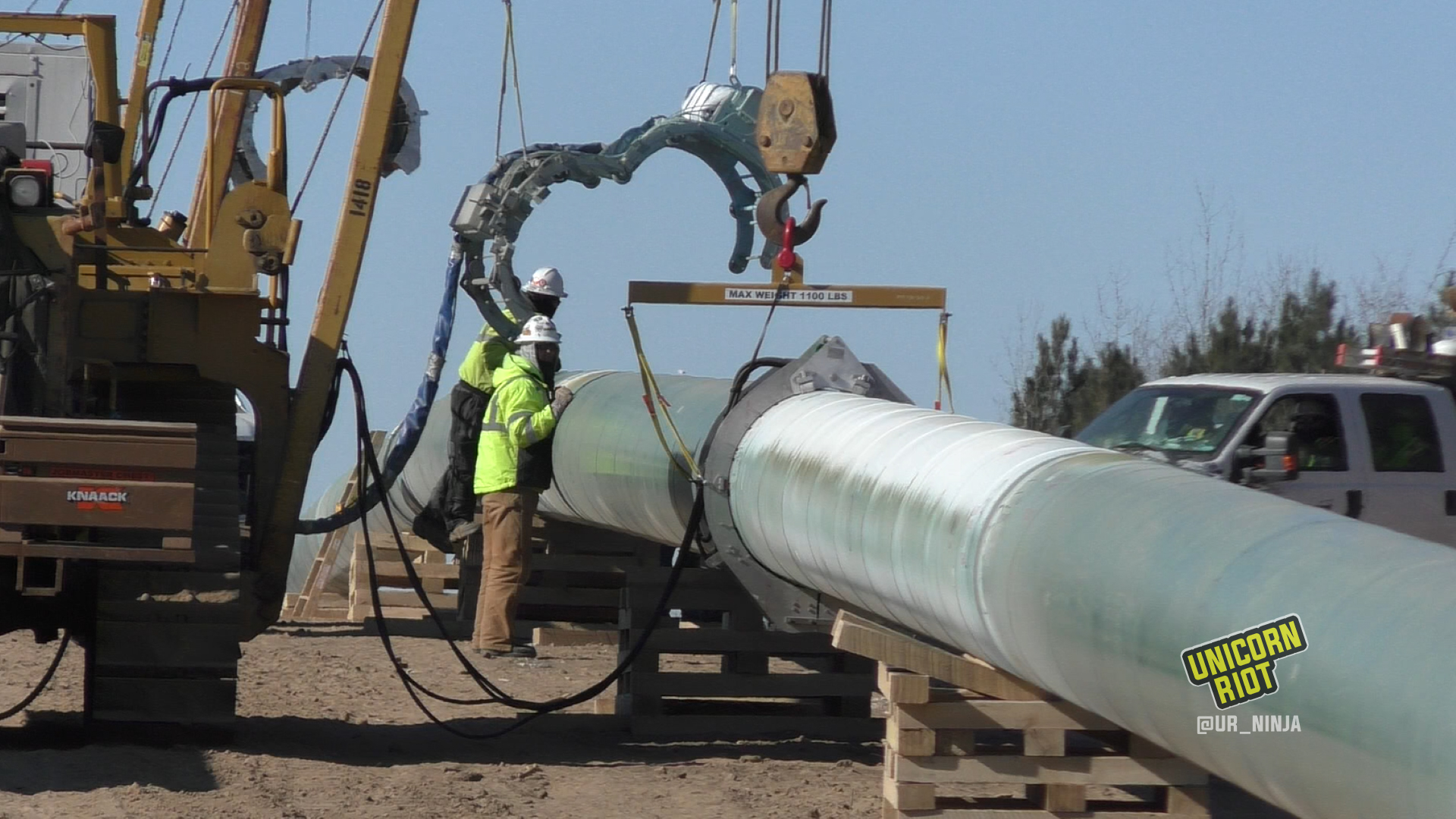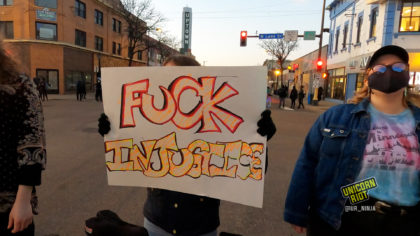Appealing Line 3 Pipeline: Supply and Demand at Root of Hearing
Minneapolis, MN – Attorneys for multiple Indigenous tribes, environmental and Indigenous rights groups, and the Minnesota Department of Commerce made oral arguments on Tuesday, March 23, against the Line 3 pipeline approvals by the Minnesota Public Utilities Commission.
The Commission approved the second-to-last permit needed for Enbridge to begin construction in the state at the end of November 2020. (The final permit needed was approved by the Minnesota Pollution Control Agency a few days later.) Although only four months have passed, the MN section of the pipeline is about halfway complete.
These last four months, and for years prior, have been full of actions taken outside of legal proceedings, as well. Water protector, Tania Aubid, was on a hunger strike opposing Line 3—Tuesday was her 38th and last day. We heard from Aubid during a protest in Bemidji against neglect in Beltrami County Jail, where several have died in recent years.
During the appeals hearing, the plaintiffs made various arguments, but the one they kept coming back to concerned the Certificate of Need. Katherine Hinderlie, attorney for the MN Department of Commerce, told the court that the decision by the Commission was “affected by legal error” and that it failed to evaluate a demand forecast for the energy being transported.
Hinderlie shared with the court that Enbridge did not provide evidence of a projected demand by consumers who will use the crude oil shipped through the pipeline, such as refineries, rather the “desire of crude oil producers to sell and ship as much oil as they can.”
Scott Strand, attorney for Friends of the Headwaters, added to Hinderlie’s argument by speculating that if Enbridge had evidence showing a demand forecast that was consumer-supported, they would have submitted it into record. Strand mentioned how Enbridge did not submit testimony from refineries proving the need for this crude oil because of consumer demand or buyer demand.
When the attorney for Enbridge, Christina Brusven, rebutted the plaintiffs’ arguments about supply and demand, she asserted that all Enbridge needed to prove as far as the need for the pipeline was that it will be used. Brusven argued that providing proof of the “utilization of the main line” shows that there is demand for the new line. Instead of showing any proof that forecasts the public’s need for more crude oil products, Enbridge chose to focus on how there is enough crude being produced in Canada from tar sands to ship it through the pipeline.

The two judges presiding over the hearing, Judge Lucinda E. Jesson and Judge Peter M. Reyes, Jr., questioned Brusven over and over about evidence for the demand, not the supply; however, she continued to assert that the supply is the demand.
Jason Marisam, attorney for the MN Public Utilities Commission, also argued that the demand for the pipeline can be seen through how it’s used, such as its capacity.
Judge Jesson and Judge Reyes questioned Marisam about evidence of the demand. He then declared an assumption of the constant demand can be made with historical and current data.
Judge Reyes pushed Marisam further by reminding him that Enbridge is required to submit a forecast of demand, including from refineries. Reyes asked him directly if there was a forecast of demand for refineries, to which Marisam said, “I don’t accept all of that.”
Reyes snapped back: “It’s a ‘yes’ or ‘no’ question.”
Plaintiffs brought up the Environmental Impact Statement model by the Commission for a potential spill into Lake Superior and its watershed. David Zoll, attorney for the Mille Lacs Band of Ojibwe, argued that the Commission should have chosen a closer water crossing to model—the Commission chose Little Otter Creek, which is thirty miles upstream.
Zoll questioned why they did that, and argued that they needed to choose a place where it was most likely for a spill to reach Lake Superior, so people of the court and the public could know the consequences.
At the end of the hearing, which lasted an hour and a half over Zoom, the judges reminded everyone that their decision would be made no later than June 21. Because the court denied an injunction to halt construction until a decision is made, the pipeline could be complete or incredibly close by then.
“With respect to whether the appeal would be rendered meaningless, the Tribes relied on Enbridge’s estimate that construction will take six to nine months to argue that construction of the pipeline may be completed before this court issues a final decision, potentially mooting the appeal.”
MN Court of Appeals Denial of Stay
The MN Court of Appeals wrote in their denial, that “even if construction is complete, this court will be able to ‘cease operation of the pipeline,’ which would ‘remove the risk of an accidental oil spill . . . the most serious potential impact raised by opponents of the Project.’”
Even with the possibility that the construction is complete by the court’s decision, the plaintiffs’ attorneys expressed optimism that the court will side with them.
“I’m feeling good, and I am hopeful that this gets sent back, which, you know, would not be the end of the Line 3 fight, but would be a pretty darn huge win.”
Brent Murcia, student attorney for Youth Climate Intervenors
Follow us on X (aka Twitter), Facebook, YouTube, Vimeo, Instagram, Mastodon, Threads, BlueSky and Patreon.
Unicorn Riot's Line 3 Oil Pipeline Coverage:
- Landing Page for all Unicorn Riot Line 3 Resistance Coverage
- Minnesota Attorney General Keith Ellison Speech Disrupted by Water Protectors - October 8, 2021
- Over 50 Line 3 Pipeline Protesters Arrested Outside MN Governor’s Residence - September 22, 2021
- Police Break Up Ceremony and Indigenous-Led #StopLine3 Occupation - August 31, 2021
- Hundreds March from Governor Residence, Urge Chase Bank Defund Line 3 - August 31, 2021
- First Trial from Treaty People Gathering Ends in Acquittal - August 23, 2021
- Line 3 Opponent Sentenced to Thirty Days in Jail - August 19, 2021
- Enbridge Spills 10,000 Gallons of Line 3 Drilling Fluid - August 16, 2021
- Line 3 Fusion Center Data Declared Secret - August 4, 2021
- Judge Orders Sheriff to Halt Harassment of Line 3 Resistance Camp - July 24, 2021
- Water Protectors Occupy Work Sites and Lock Down to Line 3 Pipeline Construction - July 1, 2021
- Hubbard County Barricades Private Property, Imprisons Water Protectors - June 28, 2021
- Indigenous-Led Blockades Occupy Line 3 Pipeline Sites - June 10, 2021
- Rising Up to the Heat: ‘Treaty People Gathering’ Resists Line 3 Pipeline - June 7, 2021
- Activists Serve Denver Wells Fargo Eviction Notice - May 3, 2021
- Appealing Line 3 Pipeline: Supply and Demand at Root of Hearing - March 23, 2021
- Caravan Disrupts Line 3 Construction Routes, Carlton County Triggers Backlash - March 13, 2021
- Treaty Rights Asserted During Creation of White Earth Camp - March 13, 2021
- 70 Water Protectors Cited, 1 Arrested During Line 3 Commemorative Rally - March 4, 2021
- Bipod and Car Blockade Jam Up Line 3 Construction - March 2, 2021
- Three Lock Down Inside Line 3 Pipeline For 6+ Hours - Feb. 21, 2021
- Lockdown to Keep it in the Ground: Line 3 Resistance - Feb. 15, 2021
- Court of Appeals Denies Motion to Stop Line 3 - Feb. 3, 2021
- Opposition to Line 3 Mounts - Jan. 29, 2021
- Resistance to Line 3: Direct Actions Aim to Stop Construction - Jan. 11, 2021
- Enbridge Line 3 Construction Blocked by Activists in Northern Minnesota - Nov. 18, 2020
- Protests After Permits for Line 3 Oil Pipeline Approved - Nov. 17, 2020
- ‘No KKKops, No Pipelines’ Banner Dropped in Minneapolis - Oct. 6, 2020
- “Divest from Climate Change!” Chase Bank Branch Protested on Opening Day - Nov. 7, 2019
- March to Protect The Sacred on Indigenous People’s Day 2019 - Oct. 14, 2019
- Hundreds Rally in Opposition to Line 3 Tar Sands Pipeline in Minnesota - Sept. 28, 2019
- Direct Action in Minnesota as Line 3 Pipeline Approval Reversed - June 3, 2019
- Multi-Agency Task Force Prepares “Rules of Engagement” For Line 3 Protests - Feb. 11, 2019
- ‘Valve Turners’ Shut Down Enbridge Oil Pipelines in Minnesota - Feb. 4, 2019
- Arts, Culture, and Hip Hop Resist Line 3 as Lawsuits Against Approval Continue - Dec. 29, 2018
- Minnesota Police Train at Military Base as Line 3 Pipeline Protests Escalate - Oct. 25, 2018
- Judge Accepts Water Protectors’ Climate Change Necessity Defense - July 18, 2018
- Line 3 Oil Pipeline Approved By Minnesota Regulators - June 28, 2018
- As Line 3 Oil Pipeline Decision Looms, Indigenous Resistance Increases - June 26, 2018
- Interfaith Community Delivers Letter of Line 3 Opposition to Minnesota Government Offices - June 4, 2018
- Minnesota Public Utilities Commission Requests Line 3 Schedule Change - Jan. 10, 2018
- Rally Against Line 3 Minnesota Pipe Yards - Dec. 11, 2017
- Resistance to Line 3 Pipeline Seeks to Save Sacred Manoomin - Oct. 9, 2017
- Direct Action Ramps Up Resistance to Line 3 - Sept. 18, 2017
Please consider a tax-deductible donation to help sustain our horizontally-organized, non-profit media organization:



